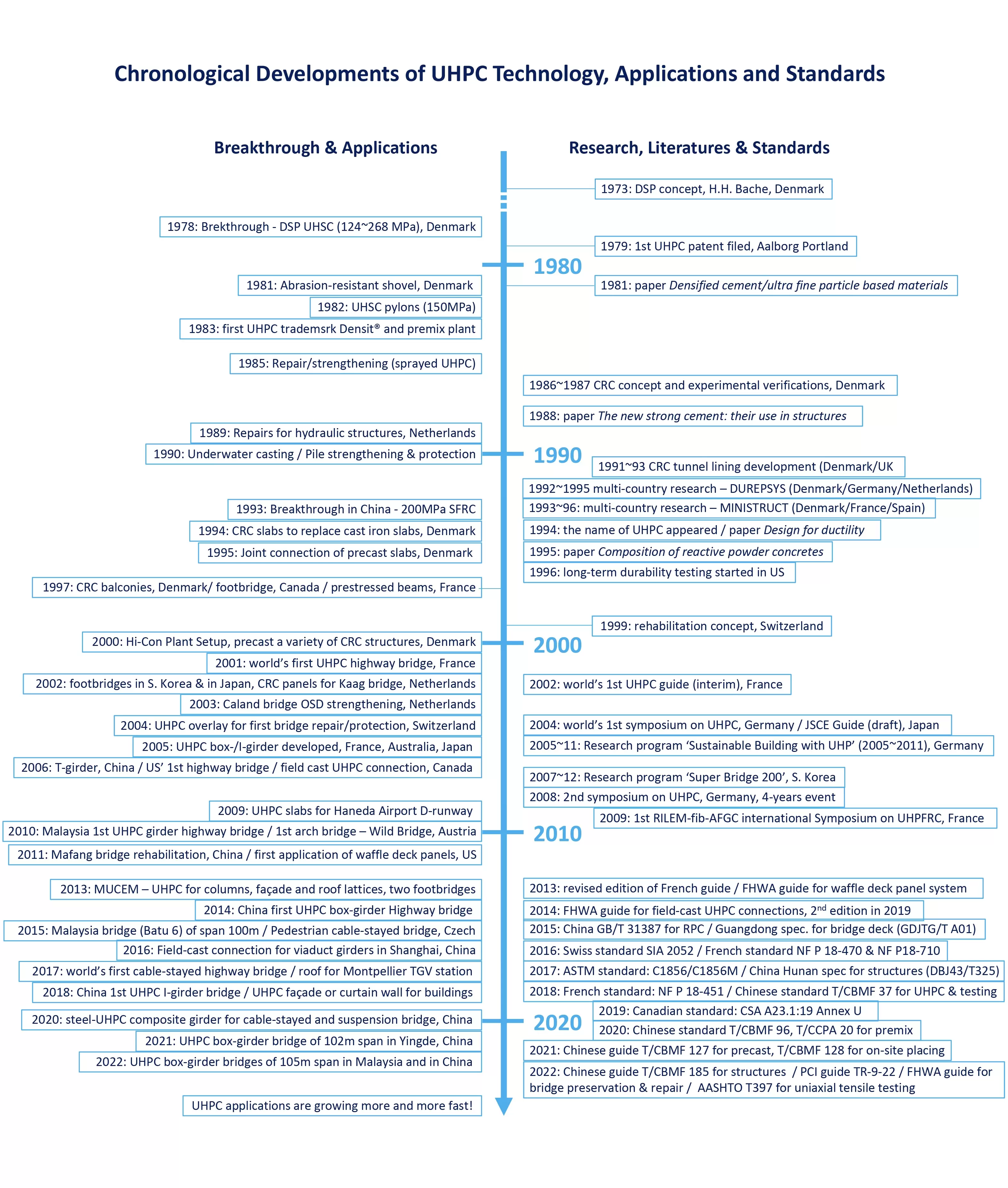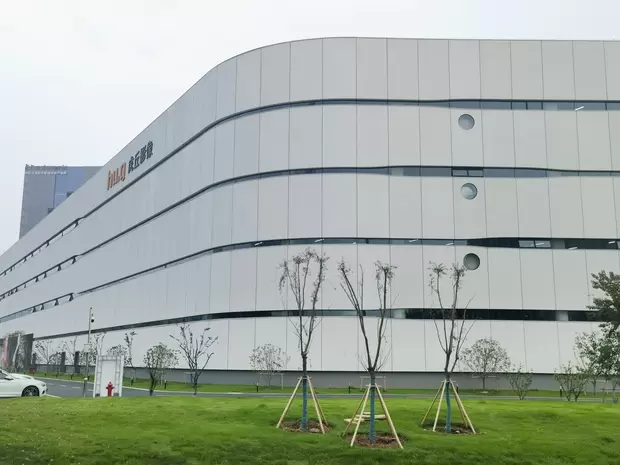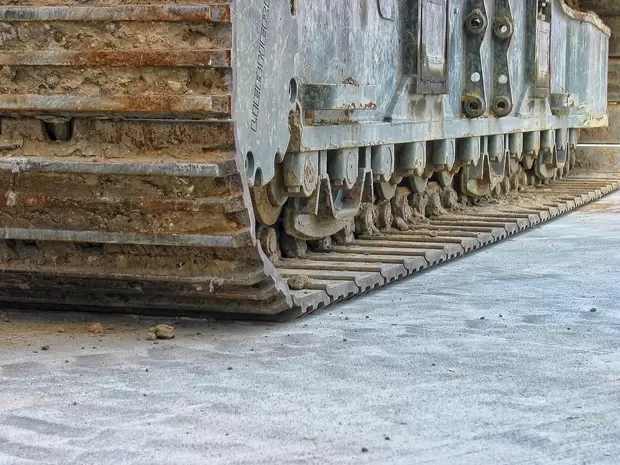From DSP concept, breakthrough of UHSC and UHPC to today, in half-century, UHPC technologies and applications have been developed step by step, UHPC guides and standards have been created from scratch, and increasingly progresses have been made in recent years. Herewith, some important breakthroughs, progresses and events are recorded in chronological sequence, based on the author’s observations and viewpoints.

1973: DSP concept, Denmark
The DSP concept was proposed by Hans Henrik Bache in 1973, but never experimentally realized until superplasticizer available.
1978: Breakthrough of USHC and UHPC / UHPFRC, Denmark
Mr. Hans Henrik Bache, Aalborg Portland A/S, Denmark, experimentally succeeded in making ultra-high strength concrete (USHC, compressive strength 124~268MPa) based on his DSP concept, and created a new method to obtain particles packing density in range 0.70~0.80 of the paste. This was the breakthrough for attaining very dense mortar or concrete simply by mixing and well dispersion of cement, ultrafine particles (primary silica fume), aggregate and superplasticizer, instead of compaction with high pressure, so it’s a much easier and practical method to produce USHC and UHPC or UHPFRC – the new construction industry materials.
1979: 1st patent for UHPC, Denmark
Aalborg Portland A/S, Denmark, filed the 1st UHPC patent (European patent): Shaped article and composite material and method for producing same (Inventor: Hans Henrik Bache, Publication number: 0010777A1, Application number: 79104321.9, Date of filing: 05.11.79). This comprehensive patent document presented the DSP concept, a range of mix / composite examples and their properties, including the earliest cementitious composites reinforced with polypropylene (pp) fibres to have strain-hardening behavior in direct tension and bending.
1981: 1st paper for UHPC / innovative application – Abrasion-resistant shovel, Denmark
Published the 1st UHPC paper: Densified cement / ultra-fine particle-based materials, written and presented by Mr. H. H. Bache at the Second International Conference on Superplasticizers in Concrete, June 10-12, 1981, Ottawa, Ontario, Canada. At this conference, Mr. H.H. Bache publicized his inventions and the principles that laid the foundation for preparing UHPC materials, and discussed the possibility of applications.
Innovated feed shovel for cement mill made of R-UHPC with strong & wear-resistant aggregates (bauxite), 3%-vol steel fibres, compressive strength of about 225 MPa. Designed by Mr. Knud Lund Eriksen at Aalborg Portland A/S, Denmark. The operation lifetime of the shovels made of wear resistant UHPC was 5~10 years, ten-time longer in comparison with the earlier types, made of cast steel.[1]
1982: New structure – UHSC hollow, prestressed pylons, Denmark
Hollow, prestressed pylons for catenary support (section size 200x300mm, wall thickness 30 and 40mm, length 10m) made of 150MPa concrete (Densit® without fibres, with dmax = 5mm natural aggregates), reinforced with Ø5mm prestressed wires, precast by Dansk Spendbeton, Lind, Denmark.[1] In 1994, Bache commented on these pylons – the earliest structures made of 150MPa concrete: ‘Inspection after 10 years' service (1993) showed excellent performance. … In a new design I would consider using 1~2% - vol. fibres (which would typically increase the fracture energy and the material ductility by a factor of 10-20) and perhaps reduce the thickness of the walls.’[2] These pylons in North of Copenhagen, if still in service nowadays, have stood for 40+ years, should be valuable specimens for durability study, specially, whether the prestressed wires are well or not protected from corrosion by the cover as thin as 12.5mm.
1983: 1st Trademark & premix plant for UHPC, Denmark
The 1st factory for producing UHPC premix with trademark Densit® established by Aalborg Portland A/S, Denmark.
1985: New construction method – Sprayed UHPC
Sprayed UHPC was firstly used for repair/strengthening of concrete structures (bridge, tunnel, industrial facilities, etc.).
1986~1987: CRC concept and experimental verifications, Denmark
Based on the fracture mechanical approach, H.H. Bache developed the CRC concept, and CRC (Compact Reinforced Composites) structures could have compressive strength 150~400 MPa, bending strength 100~300 MPa, E-modulus 40~80 GPa, good fire resistance and exceptional durability, as well as excellent explosion and penetration resistance. In 1986, Aalborg Portland A/S filed the patent: CRC.
1988: Landmark paper
Paper The New Strong Cements: Their Use in Structures by H.H. Bache, published in Physics in Technology (V19, 1988). This paper introduced the concept, research progress and anticipation of CRC (Compact Reinforced Composites) – the heavily reinforced UHPC with strength and toughness to rival steel, yet more usable than steel for large structures.[3]
1989: Innovative application – Repairs for hydraulic structures, Netherlands
UHPC to be firstly used for various repairs for hydraulic structures in Netherlands – locks and sluices damaged by abrasion-erosion.
1990: New construction method – Underwater casting / Pile strengthening & protection
Underwater casting UHPC for repair of a 26m long section of gas pipeline on the sea bed, where the original concrete mantle had been destroyed. A 10 cm thick reinforced mantle of R-UHPC was casted underwater without vibration for protection of gas pipeline. The UHPC (Densit® with dmax = 5 mm aggregate, 0.75%-vol steel fibres) was pumped through a hose with a diameter of 50mm to inlets from which the material flowed in and filled the space between the gas pipeline and exterior formwork. At the same time, the water was forced out at the top through outlet pipes.[1]
The first applications of UHPC to strengthening piles and offshore platforms in 1990~1993 in Venezuela (resulting in large applications in this field later).
1991: Innovative application – CRC tunnel lining
EUREKA joint research project (1990-1993) for CRC applications in tunnel and mines. The loading tests proved that the cast iron tunnel linings could be replaced with CRC linings. Research participants: Aalborg Portland (Denmark), Aalborg University (Denmark), Leeds University (UK), Cementation Mining (UK)
1992: Multi-country research project – DUREPSYS (1992~1995)
EU-funded multi-country research project (Brite/EuRam 2) – Low Cost Durable Cement-based Repair and Rehabilitation Systems (DUREPSYS, 1992~1995) launched.[4] Coordinator: Densit A/S (Denmark). Participants: Aalborg Portland A/S (Denmark), Ruhr-Universität Bochum (Germany), E. Heitkamp Rohrbau GMBH (Germany), Van Hattum en Blankevoort BV (Netherlands)
1993: Multi-country research project – MINISTRUCT (1993~1996) / Breakthrough in China
EU-funded multi-country research project (Brite/EuRam 2) – Minimal Structures Using Ultra High Strength Concrete (MINISTRUCT, 1993~1996) launched for develop and document CRC to be used in large scale.[5] Aalborg Portland A/S (Denmark) for project management and material design, Carl Bro Group AS (Denmark) for design guideline, CSIC (Spain) for durability testing (in Madrid city environment), Bouygues SA (France) for large scale structure implementation. During this research project, Bouygues SA developed their version of UHPC, and gave a new name RPC (Reactive Powder Concrete).
Based on the papers of H.H. Bache, Prof. Huang Zhengyu at Hunan University had successfully prepared steel fibre reinforced concrete with compressive strength of 200 MPa – the breakthrough in China.
1994: the name of UHPC / Landmark paper / Innovative application – CRC slab to replace cast iron slabs, Denmark
Paper Optimization of Ultra-High Performance Concrete by the Use of a Packing Model by F. de Larrard and T. Sedran, published in Cement and Concrete Research (V24, No.6, 1994). This paper firstly used the name of Ultra-High Performance Concrete (UHPC), however, it actually referred to the ultra-high strength concrete (UHSC). Nowadays, in some countries, such as US, China, etc., as well as in the context here, UHPC is defined to be the Fibre-Reinforced concrete or composite, i.e., equal to UHPFRC.
Paper Design for Ductility by H.H. Bache, in book Concrete Technology: New Trends, Industrial Applications (Published by Taylor & Francis, Chapter 8, 1994). This paper introduced the design principles, which are based on fracture mechanics, have been used by H.H. Bache for more than 15 years in connection with ultra-high strength cement-based materials – DSP materials and CRC.
CRC (R-UHPC) slabs for load carrying drain covers in the bottom of the railway tunnel between Funen and Zealand (Great Belt Link project, Denmark). Precast 43,000 drain covers (40mm thickness) with CRC, consisting of DSP binder (Densit®), natural aggregates, 6% vol. steel fibres and 8 mm dia. bars reinforcement. The CRC slabs solution had been found preferable to cast iron slabs because of lower price and better electrical performance. These CRC slabs, subjected to varying loads from trains and exposed to sea water, were designed for 100 years' lifetime, and now in service close 30 years. Suggest to examine the current status of these CRC slabs, which contain valuable durability information of UHPC structures in marine environment.
1995: Innovative application – Joint connection of precast concrete slabs, Denmark / Landmark paper
UHPC / CRC was firstly used for joint connection of precast concrete members – the precast RC slabs were connected by CRC for 2 new buildings at Aalborg University (14,000 m2) in 1995~1996.
Paper Composition of Reactive Powder Concretes by P. Richard & M. Cheyrezy, published in Cement and Concrete Research (V25, No.7, 1995). This paper was widely spread and well read, so lot of people mistook that UHPC started from Reactive Powder Concrete (RPC) in 1995.
1996 Long-term durability testing started in US
First series of RPC / UHPC specimens were placed at marine exposure station in tidal zone, Treat Island, Main State, US, for lang-term durability testing.
1997 New structures – CRC balconies / footbridge / prestressed beams
Some new designs and applications of UHPC structures
· First slender CRC (R-UHPC) balconies were produced and installed in Denmark.
· First footbridge with UHPC truss girder & deck was built in Sherbrooke, Canada
· Prestressed beams were used for replacing corroded steel beams in the cooling tower of Cattenom power plant, France.
1999: Rehabilitation concept, Switzerland
The concept of application of UHPFRC for the rehabilitation of reinforced concrete structures was proposed by Prof. Brühwiler, EPFL, in 1999
2000: Hi-Con Plant Setup, Denmark
The first plant dedicated for precast CRC / UHPC elements was set up by Hi-Con in Denmark, produced variety of elegant, slender and light CRC structures – balconies, stairs, openwork curtain wall, bridges, etc.
2001: World’s 1st highway bridge, France
The world’s first two highway UHPC bridges – Two overpasses (OA4 & OA6) on the Bourg-lès-Valence bypass in France were built with UHPC π-shaped precast prestressed girders, and the longitudinal and transversal joints of the girders were connected with the same UHPC (BSI® with dmax = 6 mm aggregate and 3% vol steel fibre).
2002: 1st UHPC guide, France / New structures – Footbridges in S. Korea & in Japan, CRC panels for Kaag bridge in Netherlands
The first guide for UHPC structure design and construction: Ultra-High Performance Fibre Reinforced Concrete – Interim Recommendations (in French & English), prepared by AFGC and SETRA, France
Seonyu footbridge in S. Korea, Sakata Mirai footbridge in Japan were built. Sakata Mirai footbridge is also used for long-term exposure testing for UHPC durability in marine environment. CRC (R-UHPC) deck panels were used for Kaag bridge rehabilitation in Sassenheim, Netherlands.
2003: Innovative application – Caland bridge OSD strengthening
Epoxy-bonded R-UHPC overlay was firstly used to strengthen the orthotropic steel bridge deck (OSD) of Caland bridge in Netherlands in 2003, hereafter, applied to strengthening several bridges in Netherlands.
2004: World’s 1st symposium on UHPC / Innovative application
The world’s first international symposium on UHPC held in Sept. 13-15, 2004 at University of Kassel, Germany.
UHPC overlay was firstly used for rehabilitation, widening and protection of a highway bridge over the river la Morge, nearby Sion, Switzerland.
A slab on channel-bridges in the Alps in France was repaired with UHPC in 2004, and proved to perform excellent for both abrasive & impact resistance.
Japan Society of Civil Engineers published Recommendations for Design and Construction of Ultra High Strength Fiber Reinforced Concrete Structures (Draft) in Japanese in 2004, translated into English in 2006.
2005: New structures – UHPC box-/I-girder developed / Research program - Sustainable Building with UHPC (2005~2011)
Highway bridges with various types of UHPC girder were designed and constructed,
· UHPC box-girder for PS34 overpass in France
· UHPC I-girder and traditional RC slab for St Pierre La Cour bridge in France and for Shepherds Creek Road bridge in Australia
· Composite I-girder for Horikoshi Highway C-ramp Fukuoka bridge in Japan, etc.
‘Sustainable Building with UHPC’ of the German Priority Program SPP1182 funded by Deutsche Forschungsgemeinschaft (DFG, German Research Foundation) started, 26 universities and industrial research institutes participated for 33 projects / subjects (2005~2011).
2006: New structures – UHPC T-girder in China, US’ first UHPC highway bridge, joints connection with UHPC in Canada
China first UHPC T-girder bridge for Cao-qian railway was constructed. Numerous cable trench covers made of UHPC were used for China high-speed railway since 2006.
US’ first UHPC highway bridge – Mars Hill Bridge with UHPC bulb-tee beams was constructed in Wapello County, IA.
In Canada, UHPC was firstly used for joints connection between precast panels and shear connector panels of bridge on Highway 11 over CN Railway at Rainy Lake, Ontario.
2007: New structures / Research program – Super Bridge 200 (2007~2012)
New Gärtnerplatz footbridge with UHPC slabs was constructed in Kassel, Germany
Super Bridge 200 research program (2007~2012) started in S. Korea with target of 20% reduction in construction and maintenance cost, service life of key members up to 200 years.
2008: 2nd symposium on UHPC
The 2nd international symposium on UHPC held at University of Kassel, Germany, and becomes an important platform for UHPC communication & discussion in every 4 years.
2009: French series of symposium on UHPC / UHPC slabs for Haneda Airport D-runway
1st RILEM-fib-AFGC international Symposium on UHPFRC held in Nov. 2009, Marseille, France.
UHPC slabs, pretensioned in two directions, were used for constructing the platform of Haneda Airport D-runway, prefab 6,900 ribbed slabs of size 7.8 m x 3.6 m.
In US, UHPC was firstly used for joints connection between precast full-depth deck panels of the bridge on State Route 23 over Otego Creek in Oneonta, NY.
2010: New structures – Malaysia first UHPC girder highway bridge /First UHPC arch bridge – Wild Bridge, Austria
Malaysia first UHPC girder highway bridge (Kampung Linsum bridge) was built, hereafter, the number of bridges with various types of UHPC girder is growing rapidly in Malaysia.
The world's first UHPC highway arch bridge – Wild Bridge was constructed in Austria.
2011: Innovative application – Mafang bridge rehabilitation, China / First application of UHPC waffle deck panels, US
In China, the first steel-UHPC (also named STC, Super Toughness Concrete) composite deck was used for rehabilitation of Mafang highway bridge in Zhaoqing, Guangdong Province, and proved to be an excellent solution for preventing steel deck and pavement above from early damages, then getting increasingly popular in China for new bridge constructions and old bridge rehabilitations.
UHPC waffle deck panels (two-way-ribbed, modular deck panels) were firstly used for highway bridge – Little Cedar Creek Bridge in Wapello County, Iowa, US. All connections from panel to panel and from panel to beam used field-cast UHPC, continuity connections.
2013: French guide / US guide / New Structures – MUCEM
The revised edition of the first guide Ultra High Performance Fibre-Reinforced Concretes – Recommendations (in French & English), published by AFGC, France, June 2013
Published FHWA guide: Design Guide for Precast UHPC Waffle Deck Panel System, including Connection (FHWA-HIF-13-032), US, June 2013
MUCEM (Museum of European and Mediterranean Civilization) – its tree-like columns, façade and roof lattices, 115m and 69m long pedestrian bridges were made of UHPC.
2014: Guide for field-cast UHPC connections / China first UHPC box-girder highway bridge
Published FHWA guide: Design and Construction of Field-Cast UHPC Connections (FHWA-HRT-14-084), revised 2nd edition published in 2019
China first UHPC box-girder Highway bridge was constructed in Hebei Province.
2015: Chinese standards / UHPC box-girder bridge of span 100m, Malaysia / Pedestrian cable-stayed bridge with UHPC girder, Czech
Published the first China national standard: Reactive Powder Concrete (GB/T 31387-2015)
Published provincial standard: Technical Specification for Ultra-High Performance Light-weighted Composite Deck Structure (GDJTG/T A01—2015), Guangdong Province, China.
UHPC box-girder bridge (Batu 6) of span 100m was constructed in Malaysia.
Pedestrian cable-stayed bridge with UHPC girder, span 156m – Celakovice bridge, was constructed in Czech Republic.
UHPC arch footbridge of span 10m was built in Fuzhou, China.
2016: Swiss & French standards / New applications
Published Swiss standard: SIA 2052 Recommendation: Ultra-High Performance Fibre Reinforced cement-based Composites (UHPFRC) – Construction material, dimensioning and application (in French & German)
Published French standard: NF P 18-470 Concrete — Ultra-High Performance Fibre-Reinforced Concrete — Specifications, performance, production and conformity, NF P18-710 National addition to Eurocode 2 — Design of concrete structures: specific rules for Ultra-High Performance Fibre-Reinforced Concrete (UHPFRC) (in French & English)
In China, UHPC was used firstly for joints connection between precast viaduct girders of Highway S3 in Shanghai. UHPC box-girder pedestrian bridge was constructed in Changsha
1st International Interactive Symposium on UHPC in US, 1st International Conference on UHPC Materials and Structures in China
2017: US & Chinese standards / Innovative structures – UHPC girder for cable-stayed highway bridge in S. Korea, roof for TGV station in France
Published ASTM standard: C1856/C1856M-17 Standard Practice for Fabricating and Testing Specimens of Ultra-High Performance Concrete
Published provincial standard: Technical Specification for Reactive Powder Concrete Structures (DBJ43/T325 – 2017), Hunan Province, China
The world’s first cable-stayed bridge with UHPC girder – Legoland Theme Park Bridge was constructed in S. Korea.
China first UHPC π-girders bridge was built in Shanghai.
Montpellier – South of France TGV station – its roof consists of prefabricated double cambered, perforated and self-supporting UHPC elements.
2018: French & Chinese standards / New applications
Published French standard: NF P 18-451 Concrete - Execution of concrete structures - Specific rules for UHPRFC (in French & English)
Published CBMF (China Building Materials Federation) and CCPA (China Concrete & Cement-based Products Association) standard: Fundamental Characteristics and Test Methods of Ultra-High Performance Concrete (T/CBMF 37, T/CCPA 7-2018)
China first UHPC I-girder bridge was constructed in Guangzhou.
China started using UHPC façade / curtain wall for buildings.
2019: Canadian standard for UHPC materials
Published Canadian standard: CSA A23.1:19 Concrete materials and methods of concrete construction – Annex U Ultra-High Performance Concrete (UHPC)
2020: More standards published / Innovative structures – steel-UHPC composite girder, China
Published CBMF/CCPA standard: Premix for Ultra-High Performance Concrete (T/CBMF 96, T/CCPA 20-2020).
Steel-UHPC composite girder (steel box-girder with UHPC slab) were used for 5th Yangtze River cable-stayed bridge in Nanjing and for Qinglongzhou suspension bridge in Yiyang, China.
2021: More Chinese standards / UHPC girder of 102m span, China
Published CBMF/CCPA guide: Recommendations for Production of Precast Ultra-high Performance Concrete Components (T/CBMF 127, T/CCPA 22-2021) and Recommendations for on-site Placing Ultra-High Performance Concrete (T/CBMF 128, T/CCPA 23-2021) in China.
UHPC box-girder bridge of 102m span was constructed in Yingde, Guangdong Province, China.
2022: More standards published / UHPC girder of 105m span / Applications in Malaysia, Switzerland & China
Published CBMF/CCPA standard: Specification for Design of Ultra-high Performance Concrete Structures (T/CBMF 185, T/CCPA 35-2022).
Published PCI guide: TR-9-22 Guidelines for the Use of Ultra-High Performance Concrete (UHPC) in Precast and Prestressed Concrete
Published FHWA guide: Design and Construction of UHPC-Based Bridge Preservation and Repair Solutions (FHWA-HRT-22-065)
Published AASHTO standard: AASHTO T397 Standard Method of Test for Uniaxial Tensile Response of Ultra-High Performance Concrete
UHPC box-girder bridges of 105m span were constructed in Malaysia and in China (Zhongshan, Guangdong Province.
To end of 2022, 187 UHPC bridges with total deck area of 134,300 m2 were constructed by Dura in Malaysia.[6]
During 2003 ~ 2022, there were 350 UHPFRC applications with total volume of 15,041 m3 in Switzerland.[7]
In 2022, China's UHPC consumption exceeded 82,000 m3, 48% for bridges, 23% for buildings, and 29% for power and municipal engineering, repair and strengthening, etc.
Reference:
[1] H.H. Bache, Ny Beton – Ny Teknologi, Beton – Teknik (in Danish), Aalborg Portland, April 1992
[2] H.H. Bache, Design for Ductility, in book Concrete Technology: New Trends, Industrial Applications. Edited by A. Aguado, R. Gettu and S. P. Shah, published by Taylor & Francis, Chapter 8, p113-125, 1994
[3] H.H. Bache, The New Strong Cements: Their Use in Structures, Physics in Technology, 19:2, 1988
[4] https://cordis.europa.eu/project/id/BRE20163
[5] https://cordis.europa.eu/project/id/BRE20351
[6] Dura Booklet – 5th Edition
Image: UHPC decorative insulation integrated 3D façade wall panels for new buildings of Tongzhou Campus, Renmin University of China
This article is original. If you wish to quote or share it, please remember to attribute it to the original source.




Share on